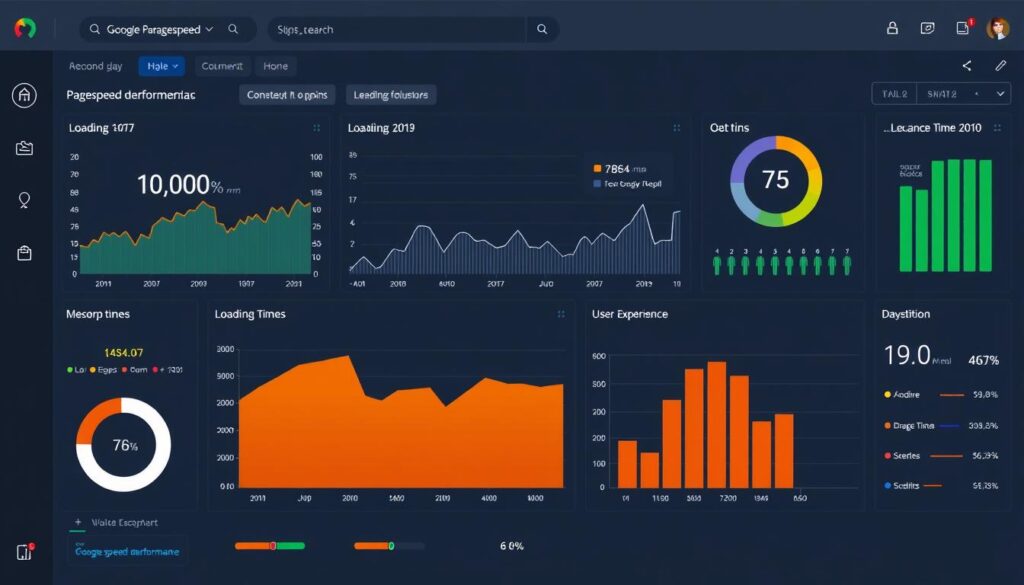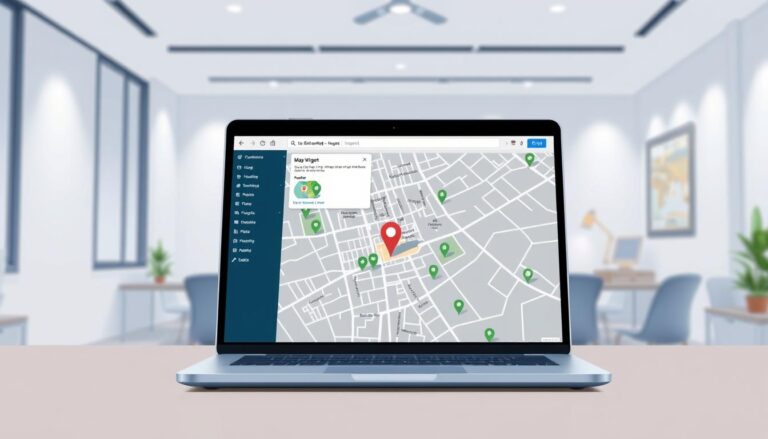When creating a website, the primary focus is on making it user-friendly and accessible. One of the key users is a search engine, which helps people discover your valuable content. SEO, or search engine optimization, plays a crucial role in making your site visible to both users and search engines.
By optimizing your site’s page speed and usability, you can significantly enhance your online presence. In this guide, I’ll walk you through the process of boosting your website’s performance to achieve better search rankings. You’ll learn how to make your content more discoverable and improve your overall online visibility.
Key Takeaways
- Discover how website speed impacts search engine rankings.
- Learn actionable techniques to optimize your site for better search visibility.
- Understand the importance of content quality for SEO.
- Enhance your website’s usability to improve user experience.
- Boost your online presence with proven SEO strategies.
Understanding the Connection Between Website Performance and Search Rankings
The connection between website performance and search engine rankings is more significant than ever. As a website owner, understanding this relationship is crucial for improving your site’s visibility in search results. Search engines like Google use complex algorithms to evaluate various aspects of your website, including its performance, to determine its ranking.

I’ll explain how search engines use sophisticated algorithms to assess your website’s performance, considering factors such as site speed, user experience, and technical optimization. This evaluation directly impacts your website’s position in search results. By understanding how search engines measure performance metrics, you can identify areas for improvement.
How Search Engines Evaluate Website Performance
Search engines employ crawlers to constantly explore and index the web. Google, being a fully automated search engine, uses these crawlers to assess website performance. The evaluation process involves analyzing various performance metrics, such as page load time, mobile responsiveness, and user engagement. These metrics provide insights into the overall user experience offered by your website.
Key Performance Metrics That Impact Rankings
Specific performance indicators have a significant impact on your search rankings. Key metrics include page load time, mobile-friendliness, and user engagement. By optimizing these metrics, you can improve your website’s performance and, subsequently, its search engine ranking. Understanding the balance between technical performance and content quality is essential for maximizing SEO impact.
By grasping the connection between website performance and search engine rankings, you can prioritize the right performance improvements to enhance your website’s visibility and ranking.
Conducting a Comprehensive Website Audit
To improve your website’s search rankings, you need to start with a comprehensive audit. This process involves analyzing your site’s current performance, identifying areas for improvement, and creating a roadmap for optimization.
Tools for Analyzing Current Website Performance
To analyze your website’s performance, you’ll need the right tools. Some essential tools include Google PageSpeed Insights, Search Console, and Lighthouse. These tools provide insights into your site’s loading speed, mobile responsiveness, and overall performance.

Using these tools, you can gain a deeper understanding of how your site is performing and identify areas that need improvement. For instance, Google Search Console helps you monitor your site’s search rankings, while Lighthouse provides a comprehensive audit of your site’s performance, accessibility, and best practices.
Identifying Critical Performance Issues
Once you have the data from your audit tools, it’s time to identify the critical performance issues that are holding back your search rankings. This involves analyzing both technical aspects, such as page speed and mobile responsiveness, and content quality.
By examining your site’s technical performance and content quality, you can pinpoint the issues that need to be addressed. This might include optimizing images, minifying CSS files, or improving the overall user experience. By prioritizing these issues, you can create a targeted plan to improve your site’s search performance.
After conducting a comprehensive website audit, you’ll have a clear understanding of your site’s strengths and weaknesses. This knowledge will enable you to make data-driven decisions to optimize your site and improve your search rankings. With the right tools and a thorough understanding of your site’s performance, you can boost your website’s visibility and drive more traffic to your site.
Optimizing Page Speed for Better Search Visibility
To enhance search visibility, it’s essential to focus on optimizing page speed. A fast-loading website not only improves user experience but also plays a critical role in search engine rankings. When you’re setting up or redoing your site, organizing it in a logical way can help search engines and users understand how your pages relate to the rest of your site.

Image Compression and Optimization Techniques
One effective way to optimize page speed is through image compression. By compressing images, you can significantly reduce the file size without compromising on quality. This not only speeds up your website but also enhances the overall user experience. Various tools are available online that can help you compress images efficiently.
Minimizing HTTP Requests
Another crucial step is to minimize HTTP requests. This can be achieved by consolidating files, optimizing resource delivery, and reducing the number of elements on your webpage. By minimizing HTTP requests, you can significantly improve your website’s loading speed, thereby enhancing user satisfaction and search engine rankings.
Implementing Browser Caching
Browser caching is a technique that allows you to store frequently-used resources locally on your users’ browsers. By implementing browser caching, you can speed up repeat visits to your website, as the browser doesn’t need to reload the same resources again. This not only improves user experience but also contributes to better search engine rankings.
By implementing these strategies, including code minification and improving server response time, you can significantly enhance your website’s performance. This, in turn, helps search engines crawl your site more efficiently and improves user satisfaction signals, ultimately boosting your search visibility.
Creating a Search-Friendly Site Structure
A logical site structure is the backbone of a successful SEO strategy, enhancing both user experience and search engine crawlability. It’s essential to create a site structure that allows both users and search engines to navigate your content easily.
Developing Logical URL Hierarchies
Developing a logical URL hierarchy is crucial for helping search engines understand your site’s organization. By using directories to group similar topics, you can help Google learn how often the URLs in individual directories change. This, in turn, can improve your site’s crawl efficiency and overall search visibility.
Organizing Content in Topic Clusters
Organizing your content into topic clusters helps establish your site as an authority on specific subjects. This approach involves creating a central “pillar” page that covers a broad topic and linking to related “cluster” content that provides more detailed information. By doing so, you can improve your site’s relevance and authority on the topic.
Implementing Effective Internal Linking
Effective internal linking is vital for distributing page authority and guiding users through related content. By linking to relevant pages, you can help search engines understand the relationships between your content and improve your site’s overall crawlability. Some best practices for internal linking include using descriptive anchor text and limiting the number of links per page.
To summarize, creating a search-friendly site structure involves:
- Developing logical URL hierarchies that clearly communicate your site’s organization
- Organizing content into topic clusters to establish authority on specific subjects
- Implementing effective internal linking to distribute page authority and guide users through related content
By implementing these strategies, you can improve your site’s search visibility, user experience, and overall search engine rankings.
How to Improve Website Performance for Search Engines Through Technical SEO
A well-optimized website is key to achieving better search engine rankings, and technical SEO plays a vital role in this process. By implementing the right technical SEO strategies, you can improve your website’s visibility, drive more traffic, and boost your search engine rankings.
Implementing Schema Markup
One effective way to enhance your website’s SEO is by implementing Schema.org markup. This involves adding structured data to your webpages to help search engines understand your content better. By including published and modified dates in your Schema markup, you can influence how your content appears in search engine results pages (SERPs) and improve crawl and recrawl rates.
- Enhance your content’s visibility with rich snippets
- Improve search engines’ understanding of your content
- Increase your website’s click-through rates
XML Sitemap Creation and Submission
Creating and submitting an XML sitemap to search engines is another crucial step in improving your website’s SEO. An XML sitemap acts as a roadmap, helping search engines crawl and index your website more efficiently. This ensures that all your important pages are discovered and indexed, making your content more accessible to users.
- Create an XML sitemap that includes all your important pages
- Submit your XML sitemap to major search engines
- Monitor and update your sitemap regularly
Managing Crawl Budget Effectively
Managing your crawl budget is essential to ensure that search engines focus on crawling and indexing your most valuable content. By optimizing your website’s structure and minimizing duplicate content, you can make the most of your crawl budget and improve your website’s overall performance.
- Optimize your website’s structure for better crawlability
- Minimize duplicate content to avoid wasting crawl budget
- Use canonical tags to specify preferred versions of pages
Mobile Optimization Strategies That Boost Rankings
Given the prevalence of mobile internet usage, adopting mobile optimization strategies is vital for enhancing your website’s search engine rankings. With mobile devices increasingly dominating internet usage, ensuring a seamless user experience across various devices is essential.
To achieve this, let’s explore some key strategies. Here are the main points to consider:
- Implementing responsive design to ensure compatibility across different devices and screen sizes.
- Utilizing Accelerated Mobile Pages (AMP) for faster content delivery on mobile devices.
- Optimizing touch elements, font sizes, and navigation for better mobile usability.
Responsive Design Best Practices
A responsive design is crucial for providing a consistent user experience across different devices. To achieve this, consider the following best practices:
- Use flexible grids and layouts that adapt to different screen sizes.
- Implement media queries to apply different styles based on device characteristics.
- Ensure that images and other media are scaled appropriately.
By following these best practices, you can ensure that your website provides a seamless user experience on both desktop and mobile devices.
Accelerated Mobile Pages (AMP) Implementation
AMP is an open-source initiative that enables the creation of fast, user-friendly mobile experiences. To implement AMP effectively:
- Create AMP versions of your web pages, focusing on text-based content.
- Use the AMP HTML library to build fast, efficient pages.
- Validate your AMP pages using the AMP test tool.
By implementing AMP, you can significantly improve the loading speed of your mobile pages, enhancing the overall user experience and potentially boosting your search rankings.
Creating High-Quality, SEO-Optimized Content
High-quality, SEO-optimized content is the backbone of a successful search engine ranking strategy. To create content that resonates with both search engines and human readers, it’s essential to understand the importance of keyword research and strategic implementation.
Keyword Research and Strategic Implementation
Effective keyword research is the foundation of creating content that ranks well in search engines. Utilize tools like Ahrefs, SEMrush, or Moz Keyword Explorer to identify valuable terms your audience is searching for. For instance, if you’re optimizing for the query “keyword research tools for SEO,” you’ll want to incorporate relevant keywords like SEO tools and keyword research naturally into your content.

Content Formatting for Better User Experience
Formatting your content for better readability and user engagement is crucial. Use headings, subheadings, and bullet points to make your content more accessible. This not only improves the user experience but also helps search engines understand the structure of your content.
Updating Existing Content for Improved Performance
Regularly updating existing content is vital to keep it fresh, relevant, and performing well in search results. Review your content periodically, and refresh it with new information, keywords, or formatting to maintain its relevance and SEO performance.
By focusing on these strategies, you can create a content framework that not only satisfies search engines but also provides value to your readers, ultimately boosting your site’s authority and search rankings.
On-Page SEO Elements That Drive Performance
To enhance your website’s search performance, it’s essential to focus on key on-page SEO elements that impact how search engines crawl and index your content. On-page SEO is vital for ensuring that your website is properly crawled, indexed, and ranked by search engines.
Crafting Effective Title Tags and Meta Descriptions
Title tags and meta descriptions are crucial for search engine results. Title tags should be descriptive and include target keywords. Meta descriptions provide a summary of the page content and should entice users to click through from search results. By optimizing these elements, you can improve your page’s visibility and click-through rates.
- Craft unique title tags for each page.
- Write compelling meta descriptions that include target keywords.
- Ensure title tags and meta descriptions are concise and within recommended character limits.
Optimizing Headings and Subheadings
Proper use of headings and subheadings helps structure your content and improves readability. Headings should be hierarchical, starting with H1 for the main title, followed by H2, H3, etc., for subheadings. This structure helps search engines understand the content hierarchy and relevance of different sections.
Strategic Use of Alt Text for Images
Using alt text for images is essential for making your content accessible and improving search engine understanding of your images. Alt text should describe the image content and include relevant keywords where appropriate. This practice helps search engines index your images correctly and can improve your visibility in image search results.
- Describe the image content accurately in alt text.
- Include target keywords in alt text where relevant.
- Use alt text for all images, including background images and graphics.
Building Quality Backlinks to Enhance Site Authority
Building high-quality backlinks is crucial for enhancing your site’s authority and search rankings. Links are a great way to connect your users and search engines to other parts of your site or relevant pages on other sites. In fact, the vast majority of the new pages Google finds every day are through links, making them a crucial resource you need to consider to help your pages be discovered by Google and potentially shown in search results.
Creating Link-Worthy Content
To attract quality backlinks, you need to create link-worthy content that other websites in your industry will want to link to. This can include in-depth guides, original research, or innovative solutions to common problems. By focusing on creating high-quality, engaging content, you can naturally attract links from other reputable sites.
- Develop comprehensive guides that provide valuable insights
- Conduct original research to offer new perspectives
- Create innovative solutions to common problems in your industry
Outreach Strategies for Link Building
Effective outreach is key to building relationships that lead to valuable backlinks. I recommend identifying relevant sites in your niche and reaching out to them with personalized messages. Highlight how your content can add value to their audience, and be prepared to offer something in return, such as a link to one of their relevant articles.
- Identify relevant sites in your niche for potential link building opportunities
- Craft personalized outreach messages that highlight the value of your content
- Be prepared to offer something in return, such as a reciprocal link
By implementing these strategies, you can enhance your site’s authority and improve your search engine rankings. Remember, the key is to focus on quality over quantity when it comes to backlinks.
Monitoring and Analyzing Performance Improvements
To gauge the success of your SEO efforts, it’s crucial to monitor your website’s performance regularly. This involves tracking key metrics that indicate how well your site is doing in terms of search engine rankings and user engagement.
Setting Up Tracking with Google Analytics and Search Console
To effectively monitor your website’s performance, traffic, and conversions, implement tracking tools like Google Analytics. These tools provide valuable insight into user behavior, allowing you to analyze and adjust your SEO strategy accordingly.

To set up comprehensive tracking, you will need to configure Google Analytics and Search Console. This involves creating accounts, adding tracking codes to your website, and configuring the necessary settings to monitor key performance indicators.
Interpreting Performance Data to Guide Strategy
Once you have set up your tracking tools, you can begin to interpret the data to guide your SEO strategy. This involves analyzing search engine rankings, organic traffic growth, and user behavior metrics to identify what’s working and what needs further optimization.
By regularly reviewing your results and adjusting your strategy, you can continuously refine your approach to maximize your search visibility and drive more traffic to your website.
After 4-6 months, you should begin to see an increase in your search engine impressions. This data-driven approach will help you make informed decisions about your SEO efforts and improve your overall website performance.
Conclusion: Maintaining Long-Term Search Performance
As we navigate the ever-changing landscape of search engine algorithms, it’s crucial to stay ahead of the curve. To achieve long-term success in SEO, it’s essential to continually adapt and refine your strategies. Throughout this article, we’ve explored key techniques for improving your website’s performance and enhancing its visibility on search engines.
To recap, we’ve discussed the importance of conducting a comprehensive website audit, optimizing page speed, and creating a search-friendly site structure. We’ve also touched on the significance of content quality, on-page SEO elements, and building high-quality backlinks. By implementing these strategies, you can significantly improve your website’s rankings and drive more organic traffic.
To maintain a competitive edge, it’s vital to stay informed about the latest trends and best practices in SEO. Regular testing and experimentation with new techniques, based on performance data and user feedback, can help you continuously improve your website’s performance. By adopting a proactive and adaptable approach to SEO, you can ensure long-term success and maintain a strong online presence.
In conclusion, SEO is a long-term investment in your company’s online success. By following the strategies outlined in this article and staying up-to-date with the latest developments in search technology, you can develop a sustainable approach to search optimization that delivers lasting results.










